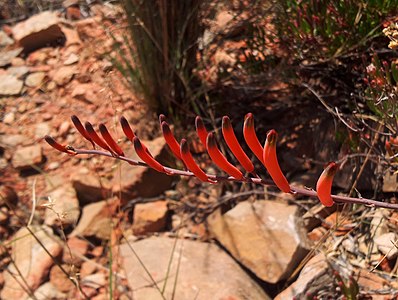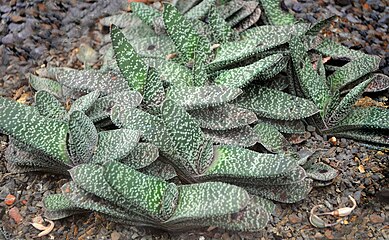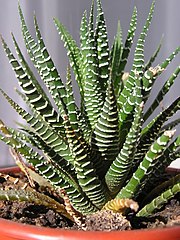Aloeae
| Aloeae | |
|---|---|

| |
| Aloe speciosa | |
| Scientific classification | |
| Kingdom: | Plantae |
| Clade: | Tracheophytes |
| Clade: | Angiosperms |
| Clade: | Monocots |
| Order: | Asparagales |
| Family: | Asphodelaceae |
| Subfamily: | Asphodeloideae |
| Tribe: | Aloeae A.Rich.[1] |
| Genera | |
|
See text. | |
Aloeae is a tribe of succulent plants in the subfamily Asphodeloideae of the family Asphodelaceae, consisting of the aloes and their close relatives. The taxon may also be treated as the subfamily Alooideae by those botanists who retain the narrower circumscription of Asphodelaceae adopted prior to the APG III system. Typically, plants have rosettes of more or less succulent leaves, with or without a distinct stem. Their flowers are arranged in racemes and tend to be either small and pale, pollinated by insects, or larger and more brightly coloured, pollinated by birds. As of 2017[update], 11 genera are recognized, most created since 2010 by splitting off another five genera from Aloe and another two from Haworthia. Only two genera, Aloe and Aloidendron, are native outside southern Africa, extending northwards to the Arabian Peninsula. Seven genera are restricted to South Africa, some with small ranges. Members of the Aloeae are cultivated by succulent plant enthusiasts; Aloe species especially are used in temperate climates as ornamental garden plants. Some species are used in traditional medicine. Aloe vera and Aloe ferox are cultivated for their extracts, whose uses include moisturizers and emollients in cosmetics.
Description
Aloeae leaves are more or less succulent and arranged in strongly tufted terminal rosettes (in arborescent species, as in Aloidendron barberae) or in basal rosettes, and are organized in distinct ranks. Leaves are succulent and have distinctive white or other uniformly coloured tubercules. This is hypothesized to be a derived condition, possibly as a mechanical defensive mechanism to make the leaf less palatable, or to prevent heat damage in arid conditions. The cross-section of the leaves is distinctly boat or crescent shaped, which represents a synapomorphy for all Aloeae taxa.[2]
The inflorescence is compacted into a many-flowered spike, or a simple or branched raceme, and is apical, although it can seem axillary. Stems are monopodial (unbranched) until an inflorescence is formed, and then sympodial (potentially branched); this prevents the rosette from dying as in Agave. Flowers of all taxa within Aloeae are tubular and have some fusion of petal-like tepals, although the amount of fusion varies among genera.[2] Differences in flower structure and colour among genera are considered to represent pollination syndromes, particularly shifts between insect and bird pollination, and so are less reliable indicators of relationships among species than was once thought. Thus Astroloba corrugata, like most species of Astroloba, has small, pale, horizontally held flowers that are insect-pollinated, whereas A. rubriflora has larger, red, vertically held flowers that are bird-pollinated.[3]
-
Astroloba corrugata – insect-pollinated flowers
-
Astroloba rubriflora – bird-pollinated flowers
Within the subfamily Asphodeloideae, Aloeae can be diagnosed by their succulent foliage, a basic chromosome number of x = 7, and the presence of specific glycosides in the leaves and anthraquinones in the roots.[3]
Taxonomy
The unity of this group of plants, the "aloes", has long been recognized, although its classification and nomenclature have varied considerably. In 1753, Carl Linnaeus followed authors before him in using a single genus, Aloe, for all the "aloes" known to him.[4] The genus was subsequently split several times; for example, Kumara was separated out in 1786, Haworthia and Gasteria in 1809.[3] Regardless of the number of genera, the "aloes" were placed in the family Liliaceae, formally described by Antoine Laurent de Jussieu in 1789. The Liliaceae sensu lato grew in scope until it included most of the lilioid monocots.[5] Attempts were made to carve out separate families. In 1802, August Batsch placed the "aloes" in the family Aloaceae rather than the Liliaceae. However, his family was rarely adopted by other botanists.[6][7]
The Dahlgren system of 1975 onwards was one of the first to produce a classification more in line with current understanding; it placed the "aloes" in the family Asphodelaceae, with the subfamily Alooideae more-or-less corresponding to Batsch's Aloaceae.[6][5] This sense of the Asphodelaceae was supported by the first APG system of 1998. However, the Angiosperm Phylogeny Group later adopted a broader circumscription, so that in the APG IV system of 2016, the Asphodelaceae sensu stricto becomes the subfamily Asphodeloideae of the Asphodelaceae sensu lato.[8] In this system, the "aloes" form the tribe Aloeae. However, the APG's approach has not been followed by many botanists, who prefer to maintain the older, narrower circumscription of the Asphodelaceae, with the "aloes" forming the subfamily Alooideae.[3]
| Family: Asphodelaceae sensu APG IV | |
| Subfamily: Asphodeloideae | Family: Asphodelaceae sensu stricto |
| Tribe: Aloeae A.Rich. | Subfamily: Alooideae Link[6] informally "alooids" |
Phylogeny
Four genera, Aloe, Haworthia, Gasteria and Astroloba, were considered "core" members of the tribe, Aloe being by far the largest genus. The genera were difficult to characterize based purely on morphological characters. Aloe in particular had few if any obvious distinctive derived characters. Molecular phylogenetic studies, particularly from 2010 onwards, suggested that the tribe should be divided into more tightly defined genera. In 2014, John Charles Manning and coworkers produced a phylogeny based on 11 genera. Aloe was divided into six genera, and Haworthia into three:[3]
| Alooideae |
| ||||||||||||||||||
More detailed cladograms show that some species placed in Haworthiopsis do not fit into the tidy pattern above. Haworthia koelmaniorum falls outside the main Haworthiopsis clade in one analysis, but was placed in that genus on the basis of other evidence. H. attenuata and H. venosa, also placed in Haworthiopsis, form a clade that is weakly placed as sister to the combination of the main Haworthiopsis clade plus Gasteria.[3]
Gordon Rowley, who first separated off Haworthiopsis from Haworthia in 2013, suggested a much broader circumscription of Tulista – essentially as the clade marked "TR" in the above cladogram.[9] This was rejected by Manning et al., but has since been defended by Rowley.[10]
Genera
As of October 2017[update], the tribe consisted of the following genera.[3] Native distributions are based on the World Checklist of Selected Plant Families; many genera are widely cultivated and introduced elsewhere.[11]
- Aloe L. – Tropical Africa, South Africa, Madagascar, Jordan to the Arabian Peninsula
- Aloiampelos Klopper & Gideon F.Sm. – South Africa
- Aloidendron (A. Berger) Klopper & Gideon F.Sm. – south-west Arabian Peninsula, Somalia, Mozambique to South Africa
- Aristaloe Boatwr. & J.C.Manning – South Africa
- Astroloba Uitewaal – South Africa (Cape Provinces)
- Gasteria Duval – South Africa
- Gonialoe (Baker) Boatwr. & J.C.Manning – Angola, Namibia, South Africa
- Haworthia Duval – South Africa
- Haworthiopsis G.D.Rowley – Mozambique, Namibia, Swaziland, South Africa
- Kumara Medik. – South Africa (south-west Cape Provinces)
- Tulista Raf. – South Africa (Cape Provinces)
Distribution and habitat
The largest genus, Aloe, with about 400 species, is natively distributed in Africa (including Madagascar), and in the Arabian Peninsula. Aloidendron, with six or seven species, also has a quite wide native distribution in southern and east Africa extending northwards to the Arabian Peninsula. The remaining genera are native only to southern Africa, some being restricted to a few locations in South Africa. Kumara, Haworthia, Astroloba, Tulista and Haworthiopsis are found in winter rainfall areas of southern Africa. Gonialoe species are found in arid regions of South Africa and Namibia.[12] Many species are cultivated as ornamental plants, and Aloe species in particular have become widely naturalized.[13]
Uses
Many species are cultivated by succulent plant enthusiasts; Aloe species in particular are used in temperate climates as ornamental garden plants.[14] Aloe vera and Aloe ferox are used in traditional medicine and cosmetics for their moisturizing and emollient effects.[15][14] Industries based on these two species were reported to be worth "millions of dollars per year" in South Africa alone.[14] Injured leaves of many species of Aloe exude a gel that contains aloin (also known as barbaloin). Aloin has been used as a laxative,[16][17] and also to add a bitter taste to foods.[18] Some species of Haworthia and Gasteria are also used in traditional medicine.[14]
References
- ^ Reveal, James L. (2011), Indices Nominum Supragenericorum Plantarum Vascularium – A, retrieved 2017-10-19
- ^ a b Smith, G.F.; Van Wyk, B.E. (1991), "Generic Relationships in the Alooideae (Asphodelaceae)", Taxon, 40 (4): 557–581, doi:10.2307/1222765, JSTOR 1222765
- ^ a b c d e f g Manning, John; Boatwright, James S.; Daru, Barnabas H.; Maurin, Olivier; Bank, Michelle van der (2014), "A Molecular Phylogeny and Generic Classification of Asphodelaceae Subfamily Alooideae: A Final Resolution of the Prickly Issue of Polyphyly in the Alooids?", Systematic Botany, 39 (1): 55–74, doi:10.1600/036364414X678044, retrieved 2017-10-22
{{citation}}: Unknown parameter|lastauthoramp=ignored (|name-list-style=suggested) (help) - ^ Gildenhuys, Sean D.; Klopper, Ronell R. (2016), "A synoptic review and new infrageneric classification for the genus Haworthiopsis (Xanthorrhoeaceae: Asphodeloideae)" (PDF), Phytotaxa, 265 (1): 1–26, doi:10.11646/phytotaxa.265.1.1, retrieved 2017-10-18
{{citation}}: Unknown parameter|lastauthoramp=ignored (|name-list-style=suggested) (help) - ^ a b Kelch, D.G. (2002), "Consider the Lilies" (PDF), Fremontia, 30 (2): 23–29
- ^ a b c Smith, Gideon F. (1993), "Familial Orthography: Aloeaceae vs. Aloaceae", Taxon, 42 (1): 87–90, doi:10.2307/1223308, JSTOR 1223308
- ^ Holmes, Walter C.; White, Heather L., "Aloaceae", in Flora of North America Editorial Committee (ed.), Flora of North America (online), eFloras.org, retrieved 2017-10-19
{{citation}}: Unknown parameter|lastauthoramp=ignored (|name-list-style=suggested) (help) - ^ Angiosperm Phylogeny Group (2009), "An update of the Angiosperm Phylogeny Group classification for the orders and families of flowering plants: APG III", Botanical Journal of the Linnean Society, 161 (2): 105–121, doi:10.1111/j.1095-8339.2009.00996.x, archived from the original on 2017-05-25, retrieved 2010-12-10
- ^ Rowley, G.D. (2013), "Generic concepts in the Alooideae 3: The phylogenetic story", Alsterworthia International, 10: 1–7; cited in Gildenhuys & Klopper (2016)
{{citation}}: CS1 maint: postscript (link) - ^ Rowley, Gordon (2015), "Tulista Raf. - Counsel for the Defence" (PDF), Alsterworthia, 15 (1): 2–3, retrieved 2017-10-20
- ^ "Taxon search", World Checklist of Selected Plant Families, Royal Botanic Gardens, Kew, retrieved 2017-10-19
- ^ Manning, John C.; Boatwright, James S.; Daru, Barnabas H. (2014), "Aloe and goodbye: a new evolutionary classification of the Alooids", Alsterworthia International, 14 (2): 7–15, retrieved 2017-10-19
{{citation}}: Unknown parameter|lastauthoramp=ignored (|name-list-style=suggested) (help) - ^ "Aloe", World Checklist of Selected Plant Families, Royal Botanic Gardens, Kew, retrieved 2017-10-19
- ^ a b c d Smith, G.F.; Newton, L.E. (2002) [copyright 2001], "Aloaceae", in Eggli, Urs (ed.), Illustrated Handbook of Succulent Plants: Monocotyledons, Berlin: Springer-Verlag, p. 102ff, ISBN 978-3-540-41692-0, retrieved 2017-10-19
{{citation}}: Unknown parameter|lastauthoramp=ignored (|name-list-style=suggested) (help) - ^ Eshun, K.; He, Q. (2004), "Aloe vera: a valuable ingredient for the food, pharmaceutical and cosmetic industries—a review", Crit Rev Food Sci Nutr, 44 (2): 91–6, doi:10.1080/10408690490424694, PMID 15116756
{{citation}}: Unknown parameter|lastauthoramp=ignored (|name-list-style=suggested) (help) - ^ Ishii, Y.; Tanizawa, H.; Takino, Y. (1994), "Studies of aloe. V. Mechanism of cathartic effect (4)", Biological and Pharmaceutical Bulletin, 17 (5): 651–653, doi:10.1248/bpb.17.651, PMID 7920425
{{citation}}: Unknown parameter|lastauthoramp=ignored (|name-list-style=suggested) (help) - ^ Lulinski, Beth; Kapica, Cathy (1998), "Some notes on Aloe Vera", Quackwatch, retrieved 2017-10-19
{{citation}}: Unknown parameter|lastauthoramp=ignored (|name-list-style=suggested) (help) - ^ IARC Working Group on the Evaluation of Carcinogenic Risk to Humans (2016), "1 Exposure Data", Some Drugs and Herbal Products, IARC Monographs on the Evaluation of Carcinogenic Risks to Humans, No. 108, Lyon: International Agency for Research on Cancer, retrieved 2017-10-19













